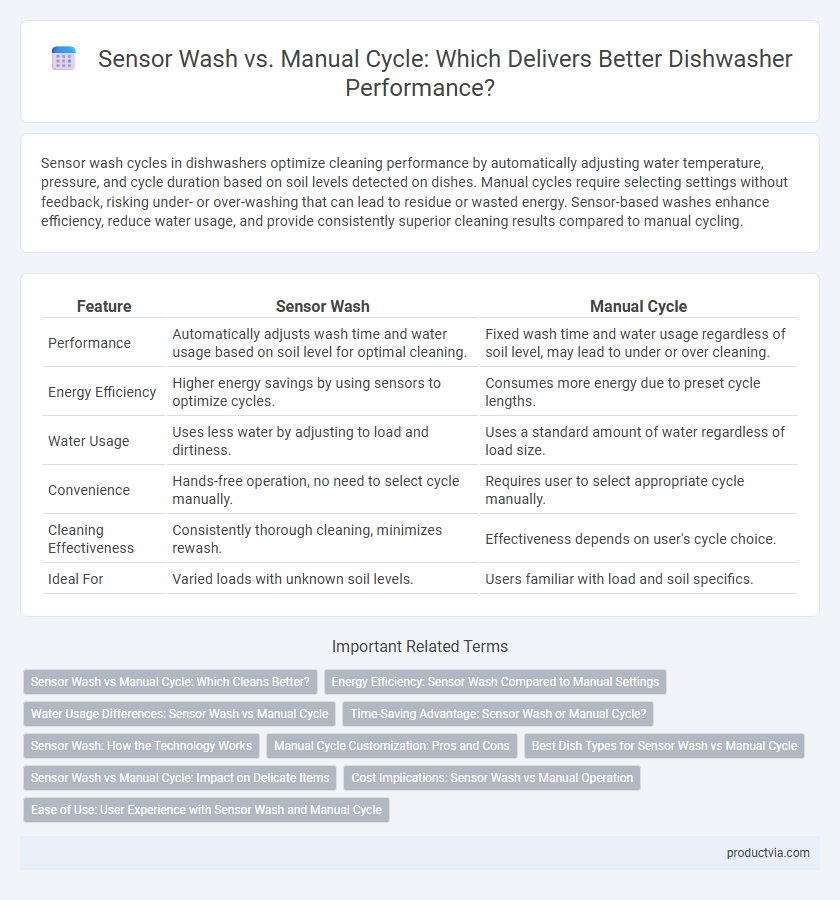Sensor wash cycles in dishwashers optimize cleaning performance by automatically adjusting water temperature, pressure, and cycle duration based on soil levels detected on dishes. Manual cycles require selecting settings without feedback, risking under- or over-washing that can lead to residue or wasted energy. Sensor-based washes enhance efficiency, reduce water usage, and provide consistently superior cleaning results compared to manual cycling.
Table of Comparison
| Feature | Sensor Wash | Manual Cycle |
|---|---|---|
| Performance | Automatically adjusts wash time and water usage based on soil level for optimal cleaning. | Fixed wash time and water usage regardless of soil level, may lead to under or over cleaning. |
| Energy Efficiency | Higher energy savings by using sensors to optimize cycles. | Consumes more energy due to preset cycle lengths. |
| Water Usage | Uses less water by adjusting to load and dirtiness. | Uses a standard amount of water regardless of load size. |
| Convenience | Hands-free operation, no need to select cycle manually. | Requires user to select appropriate cycle manually. |
| Cleaning Effectiveness | Consistently thorough cleaning, minimizes rewash. | Effectiveness depends on user's cycle choice. |
| Ideal For | Varied loads with unknown soil levels. | Users familiar with load and soil specifics. |
Sensor Wash vs Manual Cycle: Which Cleans Better?
Sensor wash cycles optimize dishwasher performance by using advanced sensors to detect soil levels and adjust water temperature, pressure, and cycle duration accordingly, ensuring thorough cleaning while conserving energy and water. Manual cycles rely on preset settings that may either underwash or overwash dishes, leading to inconsistent results and potentially higher resource use. Studies indicate that sensor wash cycles consistently outperform manual cycles in removing tough stains and achieving optimal cleanliness due to their adaptive technology.
Energy Efficiency: Sensor Wash Compared to Manual Settings
Sensor wash cycles in dishwashers optimize water and energy usage by detecting soil levels and adjusting the cycle accordingly, resulting in significant energy savings compared to manual settings. Manual cycles often run fixed times and temperatures, leading to potential overuse of water and electricity. Energy efficiency ratings consistently favor sensor wash modes for reducing utility costs and environmental impact.
Water Usage Differences: Sensor Wash vs Manual Cycle
Sensor wash cycles optimize water usage by detecting soil levels and adjusting the water volume accordingly, often using 20-30% less water than manual cycles. Manual cycles rely on preset water amounts regardless of load cleanliness, leading to potential overuse of water. Choosing sensor wash reduces water consumption significantly while maintaining effective cleaning performance.
Time-Saving Advantage: Sensor Wash or Manual Cycle?
Sensor wash cycles use advanced sensors to detect soil levels and adjust wash time automatically, resulting in optimized cleaning and significant time savings compared to manual cycles. Manual cycles require preset times that may be longer than necessary, often leading to wasted water and energy. Choosing sensor wash maximizes efficiency by tailoring cycle duration to actual load conditions.
Sensor Wash: How the Technology Works
Sensor wash technology in dishwashers uses advanced sensors to detect soil levels, water turbidity, and load size, allowing the appliance to adjust wash time, temperature, and water consumption automatically for optimal cleaning performance. This technology enhances energy efficiency by preventing overuse of water and electricity, tailoring each cycle to the specific needs of the dishes. Compared to manual cycles, sensor wash provides a smarter, more precise cleaning process that ensures better results with less resource waste.
Manual Cycle Customization: Pros and Cons
Manual cycle customization in dishwashers allows users to tailor wash settings such as temperature, duration, and intensity, offering precise control for specific cleaning needs. This flexibility can optimize performance for heavily soiled dishes or delicate items but may lead to inefficient water and energy usage if settings are improperly chosen. Unlike sensor wash cycles that automatically adjust based on soil level detection, manual cycles rely on user experience, which can result in inconsistent cleaning outcomes and potentially higher operational costs.
Best Dish Types for Sensor Wash vs Manual Cycle
Sensor wash cycles in dishwashers automatically adjust water temperature, cycle duration, and detergent use based on soil level detection, making them ideal for mixed loads with varying dirt intensity and delicate glassware. Manual cycles provide customizable settings suitable for heavily soiled pots, pans, and baked-on food, where precise control over wash parameters ensures thorough cleaning. Choosing sensor wash enhances efficiency for everyday dishes and lightly soiled utensils, while manual cycles deliver optimal results for tough stains and specialized cookware.
Sensor Wash vs Manual Cycle: Impact on Delicate Items
Sensor wash cycles use advanced moisture and soil sensors to adjust water temperature and cycle duration, ensuring gentle yet effective cleaning for delicate items. Manual cycles rely on preset settings that may apply excessive heat or agitation, increasing the risk of damage to fragile glassware or fine china. Choosing sensor wash improves performance by balancing thorough cleaning with protection, extending the lifespan of delicate dishwasher-safe items.
Cost Implications: Sensor Wash vs Manual Operation
Sensor wash cycles in dishwashers use advanced technology to detect soil levels, optimizing water and energy consumption, thus reducing utility bills compared to manual cycles. Manual operation often relies on preset times and temperatures, leading to potential overuse of water and electricity, increasing overall operating costs. Investing in sensor-based dishwashers can yield significant long-term savings through efficient resource management and lowered utility expenses.
Ease of Use: User Experience with Sensor Wash and Manual Cycle
Sensor wash cycles in dishwashers enhance ease of use by automatically adjusting water temperature, duration, and detergent levels based on soil detection, reducing user input and optimizing cleaning performance. Manual cycles require users to select wash settings, which can lead to inefficiencies or suboptimal results if wash parameters are incorrectly chosen. Sensor wash technology improves user experience by delivering consistent, efficient cleaning with minimal effort, while manual cycles offer customization for specific needs but rely heavily on user knowledge and attention.
Sensor wash vs manual cycle for dishwasher performance Infographic

 productvia.com
productvia.com